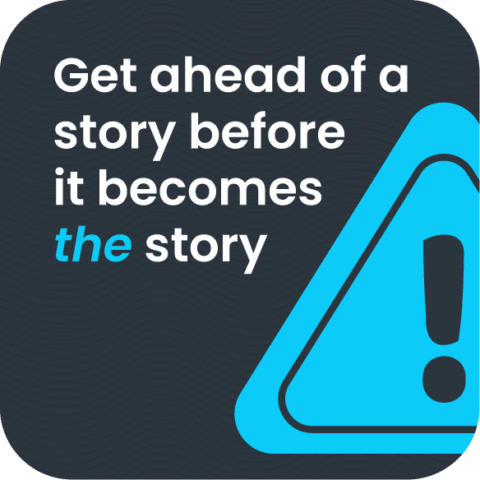A few months ago, a small neighborhood café posted a simple photo of their morning special, a latte and a lemon tart, on social media. A local food blogger reshared it, a micro-influencer praised it, and suddenly the café had a line around the block. The owner did not even know why until customers told her, “We saw you everywhere today.” The same scenario happens in reverse too: one unhappy customer posts a frustrated review, it gains traction, and revenue quietly drops before the business even realizes what happened.
In today’s digital world, one mention can change everything: your foot traffic, your sales, your reputation, even your team’s morale. Yet many small and mid-sized businesses still believe media monitoring is something only big brands need. The truth is the opposite. When conversations move fast and visibility is unpredictable, smaller businesses have more to lose and less room for error.
Media monitoring is no longer optional. It is how businesses of every size stay informed, stay competitive, and stay ahead of potential risks. Whether you are a startup, a local shop, or a growing brand, monitoring what people say about you is not just smart, it is survival.
Understanding Media Monitoring
Media monitoring is the practice of tracking every place where your brand is mentioned across the internet. This includes news articles, social media posts, customer reviews, blogs, podcasts, videos, forums, and even casual conversations happening online. In simple terms, it is your brand’s radar system. It shows you what people are saying, where they are saying it, and how those conversations may influence your reputation or sales.
Modern media monitoring tools automate this entire process. Instead of manually searching your name on Google or scrolling through social media, these tools scan thousands of sources every minute. They collect mentions, organize them, and present the information in easy-to-read dashboards and alerts. You get real-time insights without spending hours hunting for them.
Manual monitoring is slow, inconsistent, and nearly impossible to scale, especially when conversations move quickly. Automated monitoring, on the other hand, captures everything the moment it appears and highlights what needs your attention.
“Media monitoring turns scattered conversations into structured intelligence. It helps brands understand the full story instead of reacting to fragments,” says Suhail Patel, Director of Dustro.
This marks a major shift from traditional PR, where brands reacted only after major news broke. Today’s digital environment demands real-time awareness. Media monitoring allows businesses of all sizes to stay aware, stay prepared, and stay connected to the conversations that shape their future.
The Digital Landscape Has Changed and So Has PR
The digital world moves faster than any business can manually keep up with. Today, one tweet, one review, or one blog post can shape how people see a brand within minutes. A single comment from a customer can reach thousands of people before the business even knows it exists. That speed has completely changed how public relations works.
Social media has become an amplifier for everything, both good and bad. A small compliment can create unexpected demand, while a small complaint can turn into a reputation issue if ignored. Customers also expect immediate, transparent responses. They want brands to listen, acknowledge their concerns, and act quickly.
Here is what the new landscape looks like:
- One viral review can deeply influence buying decisions.
- A slow or tone-deaf response can damage trust quickly.
- Influencers and competitors shape public narratives daily.
- Industry conversations shift in real time, not on a monthly schedule.
- Customer expectations rise every time a competitor responds faster or better.
Competitors, influencers, and industry commentators introduce new ideas and highlight gaps, often before a business even notices. If a brand is not monitoring these conversations, it risks falling behind.
“The pace of digital conversations has outgrown traditional PR. If you are not tracking in real time, you are responding too late,” says Jeffrey Zhou, CEO and Founder of Fig Loans.
The truth is simple. Whether a brand participates or not, it is already part of online conversations. People are forming opinions, comparing options, and sharing experiences. Businesses that do not listen lose control of the story. In this environment, not paying attention is not just risky, it is costly. Media monitoring has become the only reliable way to stay aware, stay relevant, and stay competitive.
The Biggest Myth: Only Big Brands Need Media Monitoring
One of the most common misconceptions about media monitoring is that it is something only large corporations need. Many small business owners assume their brand is too small to attract attention or too local to be mentioned online. Others believe monitoring is a luxury service reserved for companies with big PR teams and even bigger budgets. On the surface, this seems reasonable, but in reality, it puts smaller businesses at the greatest risk.
Small and mid-sized businesses are actually more vulnerable than major brands. A single negative review, a frustrated social media post, or a critical blog article can cause a noticeable dip in revenue. Big companies have full teams ready to manage these situations. Smaller businesses do not. They rely on awareness and agility, and both depend on having the right information at the right time.
Today, media monitoring is no longer expensive or complicated. Cost-effective tools allow even tiny teams to track conversations across news, social channels, blogs, and review sites automatically. This means owners do not have to rely on guesswork or hope that customers will inform them when something goes wrong.
“Smaller businesses face amplified risk. One negative mention can reshape perception because they do not have the cushion big brands enjoy,” says Tal Holtzer CEO of VPSServer.
The contrast is clear. Big brands have departments, analysts, and crisis managers. Small businesses only have data, and media monitoring is the fastest way to access it. By knowing what people are saying, small teams can respond early, protect their reputation, and make smarter decisions. Far from being unnecessary, monitoring is one of the most valuable tools a growing business can invest in.
Core Benefits of Media Monitoring for Small & Mid-Sized Businesses
Media monitoring is not just about tracking mentions. For small and mid-sized businesses, it becomes a practical tool for growth, protection, and smarter decision-making. When used consistently, it helps teams stay aware of what customers think, what competitors are doing, and which opportunities are emerging long before they hit the mainstream. Below are the most important benefits that make monitoring indispensable.
Early Reputation Protection
Reputation is one of the most fragile assets a business owns. For a small or mid-sized business, even one negative comment can create real consequences. A frustrated customer might leave a harsh review, a community member might post a complaint, or a blogger might mention a bad experience. Without media monitoring, these moments can go unnoticed until they have already influenced customers.
“Most reputation crises begin quietly. The brands that detect the first signs are the ones that prevent public fallout,” says Kathryn MacDonell, CEO of Trilby Misso Lawyers.
With monitoring in place, businesses receive alerts the moment their name is mentioned. This gives them a chance to respond quickly, resolve concerns, and show other potential customers that they care. Instead of being caught off guard, owners can address issues before they escalate. Early awareness reduces damage, protects your image, and strengthens trust. For small businesses, this speed is the difference between a temporary setback and long-term reputation loss.
Customer Insights from Real Conversations
Small and mid-sized businesses often rely on surveys or occasional feedback to understand what customers want. However, the richest insights come from organic conversations happening online. People talk about their experiences, their frustrations, and their expectations without filters. Media monitoring captures these moments in real time.
This information reveals what customers truly value, which products interest them, and where they feel disappointed. Patterns begin to emerge. A feature request mentioned repeatedly signals demand. Praise for a specific service highlights what sets you apart. Negative experiences highlight where improvement is needed.
“Unfiltered customer conversations provide the clearest guidance. They reveal needs, frustrations, and motivations that surveys often miss,” says Grant Aldrich, Founder & CEO of Preppy.
Instead of guessing or relying on assumptions, teams can make decisions backed by real data. This helps refine marketing messages, improve offerings, and build experiences customers genuinely care about. In a crowded market, listening to real conversations gives smaller brands an advantage that feels almost unfair.
Competitive Intelligence
Competitors are not just selling products. They are shaping customer expectations, influencing industry trends, and redefining what value looks like. Without monitoring, small businesses often miss these shifts until it is too late. Media monitoring provides a clear view of what competitors are doing and how audiences are responding.
You can see when a competitor launches a new product, receives a major review, faces backlash, or becomes the center of a conversation. This knowledge lets you adjust your strategy quickly. If customers complain about a competitor’s slow service, your brand can highlight speed in its messaging. If a competitor gains attention for a new offering, you can study the response and adapt accordingly.
“Competitor monitoring is not about imitation. It is about understanding market movement and positioning your brand where the demand is growing,” says Sharon Amos, Director at Air Ambulance 1.
Competitive awareness is not about copying. It is about positioning. Media monitoring gives small and mid-sized businesses the intelligence they need to stay relevant and avoid blind spots.
Discovering New Opportunities
Beyond protection and insights, media monitoring can uncover opportunities that would otherwise stay hidden. Journalists might mention your industry in an article. Influencers might discuss a problem your product solves. Local communities might talk about a need you can fill. Monitoring tools collect these signals and surface them immediately.
These mentions often lead to partnerships, collaborations, and press opportunities. A journalist writing about a trend may be open to interviews or expert insights. A blogger discussing challenges in your niche may be looking for a solution. A forum conversation might reveal a gap in the market your business can address.
“Opportunities often appear as small mentions in niche spaces. Businesses that monitor widely discover openings others overlook,” says Anna Zhang, Head of Marketing at U7BUY.
For small businesses, these opportunities are priceless. They offer visibility, credibility, and momentum without heavy spending. By paying attention to conversations outside your immediate network, you can position your brand where it matters most. In many cases, the opportunity is already out there; media monitoring simply helps you see it.
Getting Started With Media Monitoring
Implementing media monitoring does not have to be complicated or expensive. Even small teams can build a simple, effective system that keeps them informed and prepared. The key is to start with the essentials and gradually expand as the business grows.
What Every Business Should Track
Before choosing tools, identify what you need to monitor. At a minimum, every business should track:
- The brand name and its common variations
- Competitors and their product names
- Industry keywords that signal trends
- Customer sentiment keywords such as “love,” “frustrated,” or “recommend”
- Mentions of key executives or founders, especially for thought leadership
Tracking these items helps you understand not only what people say about your brand but also the context surrounding your industry.
Setting Up an Actionable Monitoring System
Once the tools are in place, build a routine that keeps your team informed. Set up daily or weekly email reports so you never miss important mentions. Create alerts for sudden spikes in conversations, since these often indicate emerging opportunities or potential problems. Organize everything into simple dashboards that show trends at a glance. Finally, assign responsibility. Someone on the team should review updates, flag important items, and coordinate responses when needed.
With a small amount of structure, media monitoring becomes an easy habit that delivers insights every day.
The Strategic Impact of Media Monitoring on Long-Term Growth
Media monitoring is more than a day-to-day awareness tool. Over time, it becomes a strategic engine that shapes how a business grows, competes, and communicates. When a company consistently tracks conversations, it gains long-term clarity that influences everything from marketing to leadership decisions.
First, monitoring strengthens brand awareness. Businesses can see which messages resonate, which platforms drive attention, and how their reputation evolves. This helps teams refine their voice and build a brand that feels consistent and trustworthy.
Second, ongoing monitoring improves customer loyalty. By paying attention to what customers praise or criticize, a business can enhance its products, simplify processes, and address recurring pain points. This type of understanding creates stronger relationships and keeps customers returning.
“Consistent monitoring builds a strategic advantage. When decisions are informed by real conversations, growth becomes intentional rather than accidental,” says Tricia Beaudoin, Sales Manager of Active Garage Door.
Third, monitoring supports better product and service decisions. Real conversations reveal what people want, what competitors are lacking, and where opportunities exist. These insights prevent wasted efforts and guide innovation.
Fourth, it enhances PR and marketing strategy. Teams can identify trending topics, understand audience sentiment, and build campaigns that match what people are already discussing. This creates relevance, reach, and stronger engagement.
Finally, media monitoring improves crisis readiness. When businesses recognize early signs of an issue, they can respond before it becomes a serious problem. This level of preparedness builds resilience and protects long-term stability.
Over time, these benefits compound. Media monitoring becomes a foundation for smarter decisions, stronger positioning, and sustained growth.
The way people talk about businesses has changed, and those conversations now happen in public, in real time, and at a speed no company can ignore. Media monitoring is no longer a tool reserved for large corporations. It has become an essential practice for any business that wants to stay informed, protect its reputation, and compete with confidence.
Small and mid-sized businesses often feel the im
Conclusion
pact of public conversations more intensely than big brands. A single comment, review, or mention can influence customer trust and revenue. Media monitoring ensures these moments are seen early, understood clearly, and addressed with intention.
By tracking what people say, how they react, and what trends are emerging, businesses gain the clarity needed to make smarter decisions. This awareness strengthens marketing, improves customer experiences, and opens doors to opportunities that would otherwise go unnoticed.
In a digital world where every voice matters, media monitoring gives businesses the power to listen, respond, and grow. It is not just a smart investment. It is a necessary habit for long-term success.



